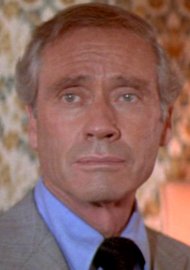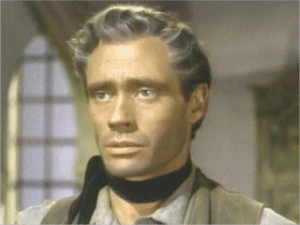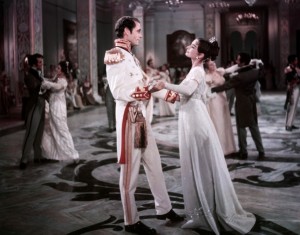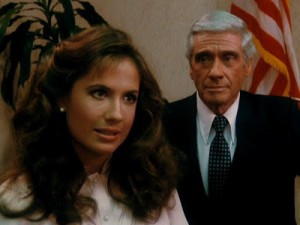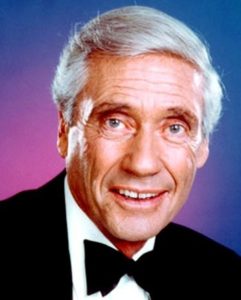MEL FERRER, TV ACTOR, PRODUCER AND FILM DIRECTOR.
Mel Ferrer was born Melchor Gastón Ferrer in the Elberon section of Long Branch, New Jersey, of Cuban and Irish descent.
His father, Dr. José María Ferrer (1857–1920), was born in la Havana, Cuba, of Spanish ancestry, and was an authority on pneumonia and served as chief of staff of St. Vincent’s Hospital in New York City. His American mother, the former Mary Matilda Irene O’Donohue (1878–1967), was a daughter of coffee broker Joseph J. O’Donohue, New York’s City Commissioner of Parks, a founder of the Coffee Exchange, and a founder of the Brooklyn-New York Ferry. An ardent opponent of Prohibition, Irene Ferrer was named, in 1934, the New York State chairman of the Citizens Committee for Sane Liquor Laws.
Ferrer had three siblings. His elder sister was Dr. M. Irené Ferrer, a cardiologist and educator, who helped refine the cardiac catheter and electrocardiogram. His brother, Dr. Jose M. Ferrer, was a surgeon. His other sister, Teresa (Terry) Ferrer, was the religion editor of The New York Herald Tribune and education editor of Newsweek. The family is not related to actors José or Miguel Ferrer.
Ferrer was privately educated at the Bovée School in New York (one of his classmates was the future author Louis Auchincloss) and Canterbury Prep School in Connecticut before attending Princeton University until his sophomore year, at which time he dropped out to devote more time to acting. He also worked as an editor of a small Vermont newspaper and wrote a children’s book, Tito’s Hats (Garden City Publishing, 1940).
Career.
Ferrer began acting in summer stock as a teenager and in 1937 won the Theatre Intime award for best new play by a Princeton undergraduate; the play was called Awhile to Work and co-starred another college student, Frances Pilchard, who would become Ferrer’s first wife that same year.
At age twenty-one, he was appearing on the Broadway stage as a chorus dancer, making his debut there as an actor two years later. After a bout with polio, Ferrer worked as a disc jockey in Texas and Arkansas and moved to Mexico to work on a novel. He then was contracted to Columbia Pictures as a director along with several other “potentials” who began as dialogue directors: Fred Sears, William Castle, Henry Levin and Robert Gordon.
Eventually, he returned to Broadway, where he directed the 1946 stage production of Cyrano de Bergerac, in which Jose Ferrer (no relation) first appeared in the role, then became involved in motion pictures, directing more than ten feature films and acting in more than eighty. As a producer, he had notable success with the well-regarded film Wait Until Dark (1967), starring Audrey Hepburn. In 1945, Ferrer made a modest directing debut with The Girl of the Limberlost, a low-budget black-and-white film for Columbia.
When he returned to Broadway to star in Strange Fruit, based on the novel by Lillian Smith. He made his screen acting debut in Lost Boundaries (1949), and as a film actor is best remembered for his roles as the injured puppeteer in the musical Lili (1953, starring Leslie Caron), as the villainous Marquis de Maynes in Scaramouche (1952) and as Prince Andrei in War and Peace (1956, co-starring with his then-wife, Audrey Hepburn).
Ferrer never achieved major stardom and later turned towards television, doing some directing for the series The Farmer’s Daughter (1963–1966) starring Inger Stevens, but is best remembered in television work for his role opposite Jane Wyman as Angela Channing’s attorney and briefly, her husband, Phillip Erikson, in Falcon Crest, as well as directing a few of the series episodes. He also played a blackmailing paparazzi reporter in the Columbo episode “Requiem for a Fallen Star” (starring Anne Baxter) and a few years later in 1979 Dr. Brogli in an episode of Return of the Saint.
For his contributions to the motion picture industry, Mel Ferrer has a star on the Hollywood Walk of Fame at 6268 Hollywood Blvd.
Personal life.
Ferrer was married five times. His wives were:
Frances Gunby Pilchard, an actress who became a sculptor; daughter of Sewell Norris Pilchard Jr, a physician, and his wife, the former Louise Collier Gunby. They married in 1937 and divorced in 1939.
Barbara C. Tripp. They married in 1940 and later divorced. They had two children: a daughter, Mela Ferrer (born 1943) and a son, Christopher Ferrer (born 1944).
Frances Ferrer (née Pilchard), who had been his first wife. This marriage, which took place in 1944, also ended in divorce. They had two children: Pepa Philippa Ferrer (born 1941) and Mark Young Ferrer (born 1944).
Audrey Hepburn, the actress, to whom he was married from 1954 until 1968. They had one child, a son, Sean Hepburn Ferrer (born 1960).
Elizabeth Soukhotine, whom he married in 1971. Before his marriage to Elizabeth Soukhotine in 1971, Ferrer also had a relationship with 29-year-old interior designer Tessa Kennedy.
Death.
A resident of Carpinteria, California, Ferrer died of heart failure at a convalescent home in Santa Barbara on June 2, 2008. He was 90 years old.
Filmography.
Last movies as Actor:
His Last Performances.
Vultures on the City (1980)
Doomed to Die (1980)
Nightmare City (1980)
Lili Marleen (1981)
Mille milliards de dollars (fr) (1982)
Deadly Game (1982)
A Soft Sunset (1984)
Peter the Great (1986) (TV miniseries)
Dream West (1986) (TV miniseries)
Eye of the Widow (1989)
Catherine the Great (1995) (TV miniseries)
Agencies/Various/Wiki/Internet Photos/YouTube/Arnoldo Varona/thecubanhistory.com
THE CUBAN HISTORY, HOLLYWOOD.
FOLLOW US ON TWITTER AND FACEBOOK. THECUBANHISTORY.COM
MEL FERRER, ACTOR DE TV, PRODUCTORA Y DIRECTOR DE CINE.
Mel Ferrer nació Melchor Gastón Ferrer en La sección de Elberon de Long Branch, Nueva Jersey, de origen cubano e irlandés.
Su padre, el Dr. José María Ferrer (1857-1920), nació en La Habana, Cuba, de ascendencia española, y fue una autoridad en la neumonía y sirvió como jefe del personal del Hospital St. Vincent en Nueva York. Su madre estadounidense, la ex Mary Matilda Irene O’Donohue (1878-1967), fue hija del corredor de café Joseph J. O’Donohue, comisionado municipal de parques de Nueva York, fundador del Coffee Exchange y fundador del Ferry de Brooklyn-Nueva York. Una enemiga ardiente de la prohibición, Irene Ferrer fue nombrada, en 1934, el presidente de Nueva York del comité de los ciudadanos para las leyes sanas del licor.
Ferrer tenía tres hermanos. Su hermana mayor fue el Dr. M. Irené Ferrer, cardiólogo y educador, que ayudó a perfeccionar el catéter cardíaco y el electrocardiograma. Su hermano, el Dr. José M. Ferrer, era un cirujano. Su otra hermana, Teresa (Terry) Ferrer, fue la redactora de religión de The New York Herald Tribune y editora de educación de Newsweek. La familia no está relacionada con los actores José o Miguel Ferrer.
Ferrer fue educado en privado en la Bovée School de Nueva York (uno de sus compañeros de clase fue el futuro autor Louis Auchincloss) y la Escuela de Preparación de Canterbury en Connecticut antes de asistir a la Universidad de Princeton hasta su segundo año, momento en el que abandonó a dedicar más tiempo a la actuación . También trabajó como editor de un pequeño periódico de Vermont y escribió un libro para niños, Tito’s Hats (Garden City Publishing, 1940).
Carrera.
Ferrer comenzó a actuar en verano como un adolescente y en 1937 ganó el premio Theatre Intime a la mejor nueva obra de un estudiante de Princeton; La obra fue llamada Awhile to Work y co-protagonizó otra estudiante universitaria, Frances Pilchard, que se convertiría en la primera esposa de Ferrer ese mismo año.
A los veintiún años, apareció en el escenario de Broadway como bailarín de coros, debutando allí como actor dos años después. Después de un combate con la polio, Ferrer trabajó como disc jockey en Texas y Arkansas y se trasladó a México para trabajar en una novela. Luego fue contratado por Columbia Pictures como director junto con otros “potenciales” que comenzaron como directores de diálogos: Fred Sears, William Castle, Henry Levin y Robert Gordon.
Finalmente regresó a Broadway, donde dirigió la producción escénica de Cyrano de Bergerac en 1946, en la que José Ferrer apareció por primera vez en el papel, luego se involucró en el cine, dirigió más de diez largometrajes y actuó en más Que ochenta. Como productor, tuvo un éxito notable con la bien considerada película Wait Until Dark (1967), protagonizada por Audrey Hepburn. En 1945, Ferrer hizo un modesto debut como director con The Girl of the Limberlost, una película en blanco y negro de bajo presupuesto para Columbia.
Cuando regresó a Broadway para protagonizar Strange Fruit, basado en la novela de Lillian Smith. Hizo su debut en la pantalla en Lost Boundaries (1949), y como actor de cine es mejor recordado por su papel como titiritero herido en el musical Lili (1953, protagonizado por Leslie Caron), como el villano Marquis de Maynes en Scaramouche (1952). ) Y como Príncipe Andrei en Guerra y Paz (1956, co-protagonizada por su entonces esposa, Audrey Hepburn).
Ferrer nunca alcanzó el estrellato principal y más tarde se volvió hacia la televisión, dirigiendo para la serie La hija del granjero (1963-1966) protagonizada por Inger Stevens, pero es mejor recordado en el trabajo de televisión por su papel junto a Jane Wyman como abogado de Angela Channing y brevemente, Marido, Phillip Erikson, en Falcon Crest, además de dirigir algunos de los episodios de la serie. También interpretó un reportero de paparazzi de chantaje en el episodio de Columbo “Requiem for a Fallen Star” (protagonizada por Anne Baxter) y unos años más tarde en 1979 el Dr. Brogli en un episodio de Return of the Saint.
Por sus contribuciones a la industria cinematográfica, Mel Ferrer tiene una estrella en el Paseo de la Fama de Hollywood en 6268 Hollywood Blvd.
Vida personal.
Ferrer se casó cinco veces. Sus esposas eran:
Frances Gunby Pilchard, una actriz que se convirtió en un escultor; Hija de Sewell Norris Pilchard Jr, un médico, y su esposa, la ex Louise Collier Gunby. Se casaron en 1937 y se divorciaron en 1939.
Barbara C. Tripp. Se casaron en 1940 y después se divorciaron. Tuvieron dos hijos: una hija, Mela Ferrer (nacida en 1943) y un hijo, Christopher Ferrer (nacido en 1944).
Frances Ferrer (née Pilchard), que había sido su primera esposa. Este matrimonio, que tuvo lugar en 1944, también terminó en divorcio. Tuvieron dos hijos: Pepa Philippa Ferrer (nacida en 1941) y Mark Young Ferrer (nacido en 1944).
Audrey Hepburn, la actriz, con quien se casó desde 1954 hasta 1968. Tuvieron un hijo, un hijo, Sean Hepburn Ferrer (nacido en 1960).
Elizabeth Soukhotine, a quien se casó en 1971. Antes de su matrimonio con Elizabeth Soukhotine en 1971, Ferrer también tenía una relación con la diseñadora de interiores de 29 años Tessa Kennedy.
Muerte.
Un residente de Carpinteria, California, Ferrer murió de insuficiencia cardíaca en una casa de convalecencia en Santa Bárbara el 2 de junio de 2008. Tenía 90 años de edad.
Filmografía.
Últimas películas como Actor:
Sus últimas interpretaciones.
Los buitres en la ciudad (1980)
Condenado a morir (1980)
La ciudad de la pesadilla (1980)
Lili Marleen (1981)
Mille millones de dólares (fr) (1982)
Juego mortal (1982)
Una puesta de sol suave (1984)
Pedro el Grande (1986) (miniserie de TV)
Sueño del oeste (1986) (miniseries de la TV)
Ojo de la viuda (1989)
Catherine the Great (1995) (miniserie de televisión)
Agencias / Varios / Wiki / Fotos de Internet / YouTube / Arnoldo Varona / thecubanhistory.com
THE CUBAN HISTORY, HOLLYWOOD.



